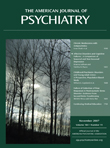Factor analytic studies describe three sectors of borderline personality disorder psychopathology: affective, behavioral, and interpersonal
(1) . The first two of these sectors,
affective instability and
impulsivity, have been conceptualized as major underlying phenotypes (i.e., for dispositions having significant heritability)
(2) . Borderline personality disorder’s third sector of psychopathology,
disturbed relationships, has traditionally been conceptualized as environmentally determined, i.e., as learned behaviors. However, these relationship characteristics are central to the clinical problems (e.g., regressions, psychotic transferences, manipulativeness, boundary problems, and countertransference reactions), as well as to major dynamic
(3,
4) and cognitive
(5,
6) theories and therapies. To reconceptualize these relationship phenomena as reflective of a third major phenotype would represent a paradigm shift that is the thesis of this editorial.
Is Borderline Personality Disorder’s Relationship Style Heritable?
To date, the heritability of the specific borderline personality disorder disturbed interpersonal style per se has not been tested in patients with borderline personality disorder. Livesley and colleagues
(11,
12) examined heritability for different forms of attachment as measured by self-report. Although the nonshared environment still accounted for most of the variance, the
secure style of attachment had a heritability of 0.37, and the
fearful and
preoccupied styles of insecure attachment—those which, as noted above, characterize borderline personality disorder—had a heritability of 0.43 and 0.25, respectively. A fourth style,
dismissive, showed no evidence for heritability. Of further note, a scale related to the borderline patients’ prototypic
intolerance of aloneness had a heritability of 0.48.
Clinical Implications
The “personality-event congruence hypothesis,” which posits that people who have an insecure relational phenotype experience stressful interpersonal events more drastically, has been confirmed in that interpersonally preoccupied or needy people are more disposed to respond to interpersonal stressors by becoming depressed
(17) . Thus, the proposed interpersonal phenotype for borderline personality disorder might also be a diathesis for some types of depressive disorder that could explain the high rate of major depressive disorder and borderline personality disorder co-occurrence—the occurrence of borderline personality disorder depending on an individual also having a diathesis for
affective instability or
impulsivity .
The existence of a disturbed relational phenotype in patients with borderline personality disorder needs to be reconciled with the etiological significance usually assigned to their dysfunctional families and to familial neglect and abuse. This article’s thesis does not exonerate the causal role of such family interactions. Indeed, much—perhaps most—of the cause for the typically disturbed relationships of subjects with borderline personality disorder is still likely to remain in the unshared environment. It does mean that dysfunctional families, as well as abuse and neglect, are neither necessary nor sufficient explanations. Moreover, it reminds clinicians that although any offsprings’ reconstruction of their past parenting should not be presumed to be valid, this is especially true for patients with borderline personality disorder, whose typically devaluative accounts of their parents likely are colored by their wish for supportive attention, by their genetically influenced tendency to overgeneralize, and by what we here suggest is a genetically influenced hypersensitivity to—or inability to accurately mentalize—parental interactions (e.g., absence, limits). A phenotype marked by high interpersonal reactivity could be expected to have influenced the actual parenting in ways that accentuated rather than minimized the disposition of subjects with preborderline personality disorder for this particular disorder.
The existence of a relational phenotype helps explain the effectiveness of psychosocial treatment interventions for borderline personality disorder
(18,
19) . Insofar as social learning experiences determine whether individuals with this phenotypic disposition do or do not go on to develop borderline personality disorder, the existence of an interpersonal phenotype actually can help explain why psychosocial interventions can have powerful effects. This article’s thesis can also help everyone involved with borderline patients—including borderline patients themselves—understand that the recurrent interpersonal problems they have with families, lovers, or treaters are constitutionally ingrained maladaptive habits. Understanding this provides a conceptualization from which families, lovers, and treaters can learn less provocative, more palliative ways of responding.

